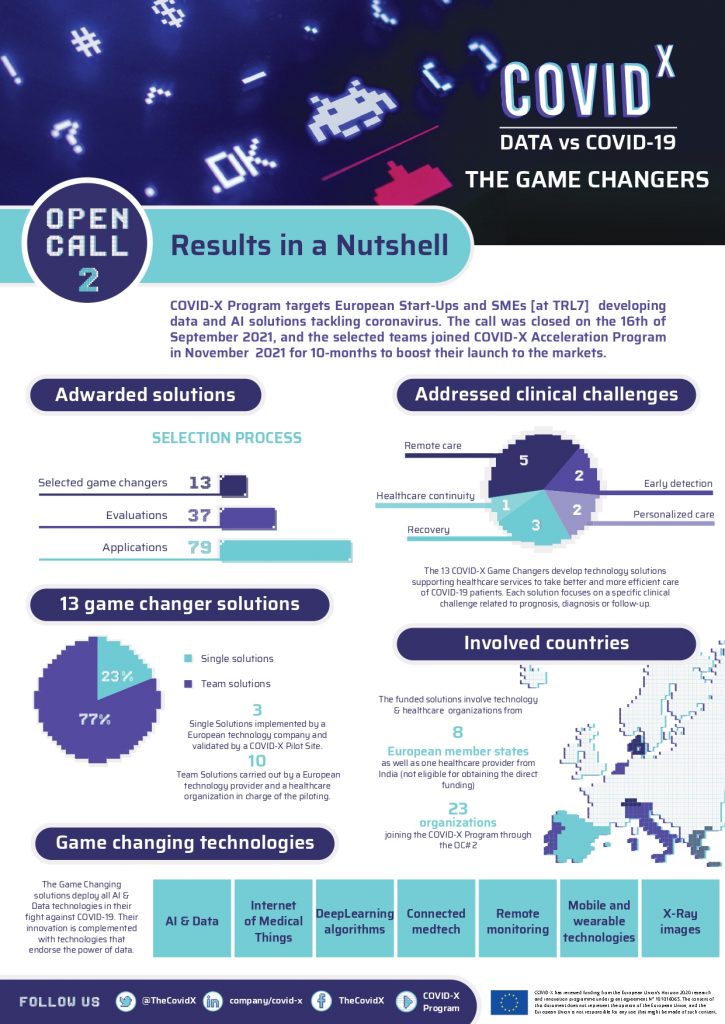The AIDE-X project was born as part of the continuous innovation process that we implement day by day in synbrAIn. The acronym AIDE-X summarizes the full project name: Artificial Intelligence for Early Detection of Lungs Diseases from chest RX Images. In fact, it is a research project that aims to support the automatic identification of pneumonia, also allowing to trace the original cause, and therefore distinguish those due to COVID-19 from other types of pneumonia. The whole process uses only radiographic images, allowing operators to compare them with those taken from other patients suffering from similar diseases.
The project offers several benefits to the end users. First, this solution allows the use of radiographs instead of tomographic images, which implies fewer amounts of radiation suffered by patients. In addition, costs are much lower for both patients and national health systems, and it is generally easier to access the equipment needed to take X-rays compared to those required for a CT scan (being more expensive and less available).
For these and other reasons, the AIDE-X project (of which synbrAIn is principal investigator) was among the very few to be selected by the scientific committee of the COVID-X program, a European innovation initiative that aims to offer access to fundings and specific acceleration programs, both for start-ups and companies. The goal is to encourage the adoption by the market of solutions based on artificial intelligence, being able to exploit the large availability of data to defeat COVID-19 and save lives. It is supported by the European Commission as part of the response plan to defeat COVID-19 through data.

Through two Open Calls, COVID-X has selected a total of 13 projects out of 73, allowing 30+ companies (including synbrAIn) distributed over 8 different European countries, to obtain equity-free funding and to get access in technical, business and ethical mentoring.
This will allow synbrAIn to make use of concrete support to ensure compliance with ethical issues related to clinical data management, as well as the possibility of validating the solution in real clinical settings, at one of the COVID-X pilot sites, distributed among Italy, Spain and Sweden. The clinical partner for the AIDE-X project will be the Humanitas Clinical Institute, which will provide the radiographs to be used for the validation of the machine learning models used by synbrAIn, together with the related diagnoses.
In addition to the above, the entire go-to-market strategy will be supported by a team of consultants made available to all companies involved in the initiative. It is interesting to specify how one of the primary objectives of COVID-X is to allow an effective transition to a higher level of technological maturity. More specifically, COVID-X refers to the Technology Readiness Level (TRL), a methodology widely adopted by various international bodies to assess the degree of technological maturity in nine levels. So TRL 1 represents the lowest maturity level, which gradually rises up to TRL 9 (real system tested in an operational environment, capable of guaranteeing competitive production). The objective of the COVID-X program is to allow companies already equipped with technologies at a TRL 7 or TRL 8, to improve up until TRL 9, offering the aforementioned support of a team of consultants with experience in this kind of technological enhancement.
Our company was able to be part of this initiative thanks to the constant developments of our technologies in the healthcare field, as already highlighted by ongoing collaboration projects such as those that led to MS HUMANAID, with a consequent technological maturity assessed in TRL 8. The possibility of being part of the COVID-X initiative is, for synbrAIn, a great recognition of the innovation work carried out day after day, and it also represents an important economic contribution for the company growth. This is particularly significant in consideration of the affinity of the AIDE-X project with our corporate mission: to develop innovative solutions for the human-machine cooperation.
For more information about the COVID-X programme, visit: www.covid-x.eu